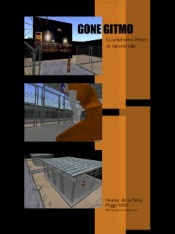I recently talked about journalism and storytelling with Nonny de la Peña, who is a senior research fellow in immersive journalism at the University of Southern California Annenberg School for Communications and Journalism, where she explores 3-D environments for news, nonfiction and documentary. She is also co-founder of Stroome.com, a community that allows online collaborative remixing of visual journalism. A graduate of Harvard University with 20 years of news experience, de la Peña is a former correspondent for Newsweek Magazine and has written for The New York Times, Los Angeles Times Magazine and many other publications. Her award-winning documentary films have screened on national television and at theaters in more than 50 cities around the world.
 I met de la Peña in London last summer and was particularly curious to hear her thoughts on “Gone Gitmo,” an immersive storytelling installation built as a virtual Guantanamo Bay prison. Funded by the MacArthur Foundation, “Gone Gitmo” was constructed inside Second Life and appeared in prototype at the Bay Area Video Coalition. Users who enter the project experience a virtual detention inside the prison camp, with documentary footage embedded to create spatial narrative. De la Peña and I connected again last month via Skype to discuss her work. The following are excerpts from our conversation.
I met de la Peña in London last summer and was particularly curious to hear her thoughts on “Gone Gitmo,” an immersive storytelling installation built as a virtual Guantanamo Bay prison. Funded by the MacArthur Foundation, “Gone Gitmo” was constructed inside Second Life and appeared in prototype at the Bay Area Video Coalition. Users who enter the project experience a virtual detention inside the prison camp, with documentary footage embedded to create spatial narrative. De la Peña and I connected again last month via Skype to discuss her work. The following are excerpts from our conversation.
You have explained that the main idea of immersive journalism “is to allow the participant, typically represented as a digital avatar, to actually enter a virtually recreated scenario representing the news story.” Immersive systems give the participant “access to the sights and sounds, and possibly feelings and emotions, that accompany the news.” How would you explain your main motivation to explore immersive journalism?
Immersive journalism really comes from understanding that there is a growing use of virtual and gaming platforms in which individuals are extremely comfortable with a virtual body. Using that as a starting point, I began to consider what that might mean for nonfiction. In the same way documentary grew in parallel with fiction film, I believe immersive journalism (which can also be considered as immersive documentary or immersive nonfiction) has an appropriate potential using new technologies. My journalistic work has often considered human rights issues, which makes it more likely such issues will be reflected in my immersive journalism work.
However, there are some very interesting questions that arise. For example, does the fact that the stories are accessed through a virtual body mean that they are necessarily subjective experiences? How do we ensure “objectivity?”
Our director of the journalism school at Annenberg, Geneva Overholser, really feels that transparency is the key here. If we can point to our sources, provide excellent research and be open to comment and criticism, immersive journalism can live up to its potential. In a sense, it’s simply about applying traditional journalistic principles to the new technologies.
Your work, as you say, is interrogating the phenomenology of narrative journalism. It seems to me that 3-D animation still presents a barrier to verisimilar storytelling in a way that “live action” or photographic realism does not...
I am not sure that is true. I think that “experience” can have value, especially given stories that are inaccessible. For example, Gitmo is off limits to most citizens and press, so we’ve made it accessible. You can read all you want to about the carbon markets, but when you literally follow the money, does that make the story better understood? And yet, the video released in the Baha Mousa case is extraordinarily disturbing, but when we built our piece in Mel Slater’s lab, that video had not yet been released. I would suggest we did a pretty good job considering that the information came from International Red Cross data and interrogation logs.
Now, what is the role of realism? If the graphics get better, will the experiences become more comparable to the realism of video now? Mel’s work has shown that the video graphics don’t have to be great to work. Still, the last piece I saw in his lab on understanding violence used extremely good audio and dialogue (as well as very good voice actors). In terms of current technology, one thing I can say: If the audio is bad, forget it.
Yet that exact same premise holds true in documentary filmmaking. If you have bad lighting but good audio, the drama can still be pronounced. Without good audio, even the best sequences can fail.
 So orality and sound still play a major role in storytelling...
So orality and sound still play a major role in storytelling...
Yes.
Are you concerned by the possible ethical implications? The proximity with video games, even serious games, the connotations of 3-D animation...
I am always concerned about ethical implications. I think the history of the use of propaganda makes it clear that we have to be ever vigilant.
I’m thinking of the widespread discourse of the first-person shooter for instance, in video games. Will people want to be in the place of the perpetrators? How would a journalist go about that, how to control the script?
I have gotten a lot of pushback on the Gitmo piece that we did not tell the story of the soldiers there. But as studies like the Stanford Prison Experiment make clear, giving people the role of the soldier can create some pretty intense scenarios. We decided it wasn’t appropriate for this project although we would be absolutely happy to have their experiences recounted in some way on the site. I would agree that the first-person shooter has to be considered carefully and ethically, but it would be a knee-jerk reaction to just shut down this avenue of storytelling based on that issue. For example, check out what happened with the Columbine game at Slamdance.
Would you say that in these exercises of immersive journalism or storytelling, the user, though he or she experiences situations physically, retains a level of passivity?
Very good question. The fact the user can move through the story raises a lot of issues. I have an earlier paper, when I was just starting to sort out the ideas about immersive journalism, which discusses such passive moments as the “embodied edit.” In “Gitmo,” that would be when we move the user along the “story” by teleporting them from place to place within the build. However, there are many moments when the user makes the decision where to go; still, they are within the context of the “news report” that is clearly consistent with reading about a story or watching it on TV.
A key aspect of your immersive journalism project is the blurring of boundaries between different fields, and one of the main elements in immersive experiences may be what you called the embodied edit. And Stroome allows users to remix, which is a form of editing...
Yes, considering how stories can be told differently in this new wave of technology. I consider immersive journalism still under development, but Stroome is about trying to give users a way to start telling stories today, collaboratively, journalistically and from different perspectives. For example, rather than write a letter to an editor or call up a TV station to dispute veracity, the audience member could just remix the story, telling it the way they see it.
Do you think that’s where journalism is headed, to giving users/readers the tools to re-tell the stories?
Once again, I quote Geneva (although I understand she borrowed it as well): The group formerly known as the audience, they are participants. Whether as sophisticated producers of content, or if they commit an “act of journalism” by capturing key footage on cell phones, Stroome supports both approaches.
How receptive do you think the major players in journalism are to this new form of storytelling, one open to empowering “the group formerly known as the audience”?
I think they are finding it very difficult. Even J-schools. I heard one major dean complain: “We are training professional journalists, not citizen journalists!” So they still aren’t recognizing how much this has all blurred. However, as Julian Assange explains in the “Wiki Rebels” documentary, at first he turned all of the data loose hoping that it would get vetted by the public, but ended up having to turn to journalists to analyze and distill and present to the public. However, what we are offering at Stroome offers really nice pillars of ways to collaborate and support. It is designed to consider how content is discoverable and not overwhelming.
And it is curated by a community and enabled by a specific platform...
Yes.
So, what you are suggesting is an important redefinition of the role of the nonfiction storyteller and therefore of the press...
Yes. In some ways both ends of the spectrum achieving the same goal. In one, similar editorial control present with news orgs now comes with having to design and build a 3-D immersive space. In the other, Stroome opens the landscape to all. Yet both focus on user participation with journalism that is unique to our technological present.
Where do you see written journalism going in this landscape?
We will always need good analysis.
Perhaps as ancillary material for the immersive or audiovisual experiences?
Yes, I agree. And sometimes the immersive component will be ancillary to the text.
-----
[Ernesto Priego is researching comics and narrative as a Ph.D. candidate in information studies in the U.K. at University College London. He has written previously for Nieman Storyboard on the death of Harvey Pekar, manga memoir and on comics as narrative journalism.]
 I met de la Peña in London last summer and was particularly curious to hear her thoughts on “Gone Gitmo,” an immersive storytelling installation built as a virtual Guantanamo Bay prison. Funded by the MacArthur Foundation, “Gone Gitmo” was constructed inside Second Life and appeared in prototype at the Bay Area Video Coalition. Users who enter the project experience a virtual detention inside the prison camp, with documentary footage embedded to create spatial narrative. De la Peña and I connected again last month via Skype to discuss her work. The following are excerpts from our conversation.
I met de la Peña in London last summer and was particularly curious to hear her thoughts on “Gone Gitmo,” an immersive storytelling installation built as a virtual Guantanamo Bay prison. Funded by the MacArthur Foundation, “Gone Gitmo” was constructed inside Second Life and appeared in prototype at the Bay Area Video Coalition. Users who enter the project experience a virtual detention inside the prison camp, with documentary footage embedded to create spatial narrative. De la Peña and I connected again last month via Skype to discuss her work. The following are excerpts from our conversation.You have explained that the main idea of immersive journalism “is to allow the participant, typically represented as a digital avatar, to actually enter a virtually recreated scenario representing the news story.” Immersive systems give the participant “access to the sights and sounds, and possibly feelings and emotions, that accompany the news.” How would you explain your main motivation to explore immersive journalism?
Immersive journalism really comes from understanding that there is a growing use of virtual and gaming platforms in which individuals are extremely comfortable with a virtual body. Using that as a starting point, I began to consider what that might mean for nonfiction. In the same way documentary grew in parallel with fiction film, I believe immersive journalism (which can also be considered as immersive documentary or immersive nonfiction) has an appropriate potential using new technologies. My journalistic work has often considered human rights issues, which makes it more likely such issues will be reflected in my immersive journalism work.
However, there are some very interesting questions that arise. For example, does the fact that the stories are accessed through a virtual body mean that they are necessarily subjective experiences? How do we ensure “objectivity?”
Our director of the journalism school at Annenberg, Geneva Overholser, really feels that transparency is the key here. If we can point to our sources, provide excellent research and be open to comment and criticism, immersive journalism can live up to its potential. In a sense, it’s simply about applying traditional journalistic principles to the new technologies.
Your work, as you say, is interrogating the phenomenology of narrative journalism. It seems to me that 3-D animation still presents a barrier to verisimilar storytelling in a way that “live action” or photographic realism does not...
I am not sure that is true. I think that “experience” can have value, especially given stories that are inaccessible. For example, Gitmo is off limits to most citizens and press, so we’ve made it accessible. You can read all you want to about the carbon markets, but when you literally follow the money, does that make the story better understood? And yet, the video released in the Baha Mousa case is extraordinarily disturbing, but when we built our piece in Mel Slater’s lab, that video had not yet been released. I would suggest we did a pretty good job considering that the information came from International Red Cross data and interrogation logs.
Now, what is the role of realism? If the graphics get better, will the experiences become more comparable to the realism of video now? Mel’s work has shown that the video graphics don’t have to be great to work. Still, the last piece I saw in his lab on understanding violence used extremely good audio and dialogue (as well as very good voice actors). In terms of current technology, one thing I can say: If the audio is bad, forget it.
Yet that exact same premise holds true in documentary filmmaking. If you have bad lighting but good audio, the drama can still be pronounced. Without good audio, even the best sequences can fail.
 So orality and sound still play a major role in storytelling...
So orality and sound still play a major role in storytelling...Yes.
Are you concerned by the possible ethical implications? The proximity with video games, even serious games, the connotations of 3-D animation...
I am always concerned about ethical implications. I think the history of the use of propaganda makes it clear that we have to be ever vigilant.
I’m thinking of the widespread discourse of the first-person shooter for instance, in video games. Will people want to be in the place of the perpetrators? How would a journalist go about that, how to control the script?
I have gotten a lot of pushback on the Gitmo piece that we did not tell the story of the soldiers there. But as studies like the Stanford Prison Experiment make clear, giving people the role of the soldier can create some pretty intense scenarios. We decided it wasn’t appropriate for this project although we would be absolutely happy to have their experiences recounted in some way on the site. I would agree that the first-person shooter has to be considered carefully and ethically, but it would be a knee-jerk reaction to just shut down this avenue of storytelling based on that issue. For example, check out what happened with the Columbine game at Slamdance.
Would you say that in these exercises of immersive journalism or storytelling, the user, though he or she experiences situations physically, retains a level of passivity?
Very good question. The fact the user can move through the story raises a lot of issues. I have an earlier paper, when I was just starting to sort out the ideas about immersive journalism, which discusses such passive moments as the “embodied edit.” In “Gitmo,” that would be when we move the user along the “story” by teleporting them from place to place within the build. However, there are many moments when the user makes the decision where to go; still, they are within the context of the “news report” that is clearly consistent with reading about a story or watching it on TV.
A key aspect of your immersive journalism project is the blurring of boundaries between different fields, and one of the main elements in immersive experiences may be what you called the embodied edit. And Stroome allows users to remix, which is a form of editing...
Yes, considering how stories can be told differently in this new wave of technology. I consider immersive journalism still under development, but Stroome is about trying to give users a way to start telling stories today, collaboratively, journalistically and from different perspectives. For example, rather than write a letter to an editor or call up a TV station to dispute veracity, the audience member could just remix the story, telling it the way they see it.
Do you think that’s where journalism is headed, to giving users/readers the tools to re-tell the stories?
Once again, I quote Geneva (although I understand she borrowed it as well): The group formerly known as the audience, they are participants. Whether as sophisticated producers of content, or if they commit an “act of journalism” by capturing key footage on cell phones, Stroome supports both approaches.
How receptive do you think the major players in journalism are to this new form of storytelling, one open to empowering “the group formerly known as the audience”?
I think they are finding it very difficult. Even J-schools. I heard one major dean complain: “We are training professional journalists, not citizen journalists!” So they still aren’t recognizing how much this has all blurred. However, as Julian Assange explains in the “Wiki Rebels” documentary, at first he turned all of the data loose hoping that it would get vetted by the public, but ended up having to turn to journalists to analyze and distill and present to the public. However, what we are offering at Stroome offers really nice pillars of ways to collaborate and support. It is designed to consider how content is discoverable and not overwhelming.
And it is curated by a community and enabled by a specific platform...
Yes.
So, what you are suggesting is an important redefinition of the role of the nonfiction storyteller and therefore of the press...
Yes. In some ways both ends of the spectrum achieving the same goal. In one, similar editorial control present with news orgs now comes with having to design and build a 3-D immersive space. In the other, Stroome opens the landscape to all. Yet both focus on user participation with journalism that is unique to our technological present.
Where do you see written journalism going in this landscape?
We will always need good analysis.
Perhaps as ancillary material for the immersive or audiovisual experiences?
Yes, I agree. And sometimes the immersive component will be ancillary to the text.
-----
[Ernesto Priego is researching comics and narrative as a Ph.D. candidate in information studies in the U.K. at University College London. He has written previously for Nieman Storyboard on the death of Harvey Pekar, manga memoir and on comics as narrative journalism.]


